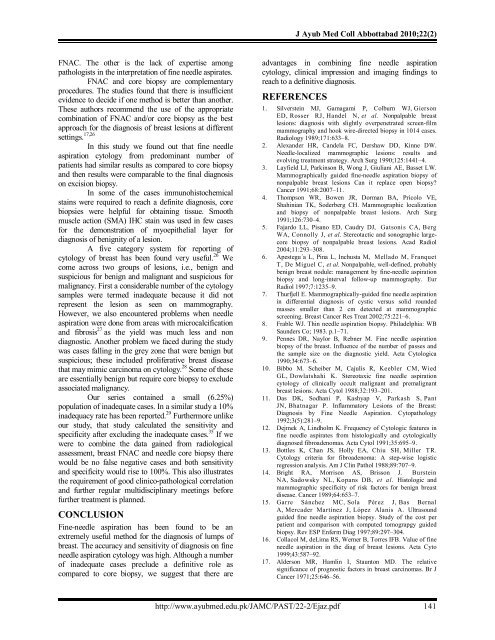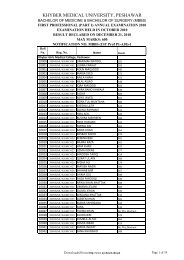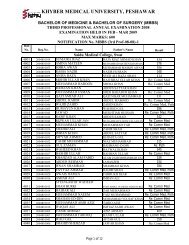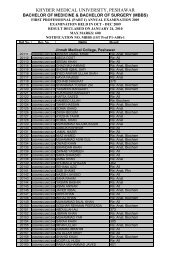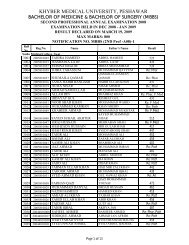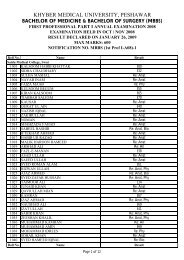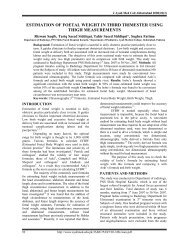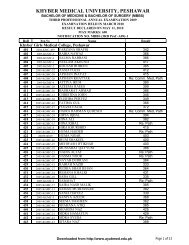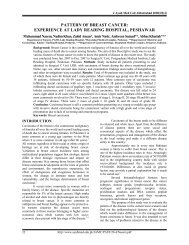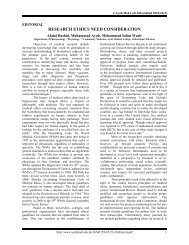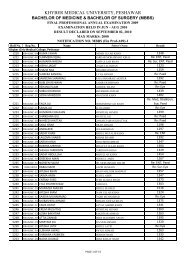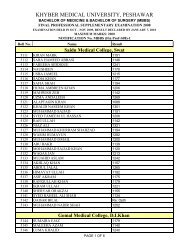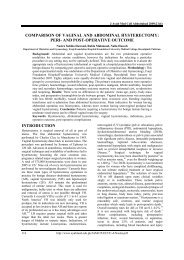ultrasound guided fine needle aspiration cytology versus core
ultrasound guided fine needle aspiration cytology versus core
ultrasound guided fine needle aspiration cytology versus core
Create successful ePaper yourself
Turn your PDF publications into a flip-book with our unique Google optimized e-Paper software.
J Ayub Med Coll Abbottabad 2010;22(2)<br />
FNAC. The other is the lack of expertise among<br />
pathologists in the interpretation of <strong>fine</strong> <strong>needle</strong> aspirates.<br />
FNAC and <strong>core</strong> biopsy are complementary<br />
procedures. The studies found that there is insufficient<br />
evidence to decide if one method is better than another.<br />
These authors recommend the use of the appropriate<br />
combination of FNAC and/or <strong>core</strong> biopsy as the best<br />
approach for the diagnosis of breast lesions at different<br />
settings. 17,26<br />
In this study we found out that <strong>fine</strong> <strong>needle</strong><br />
<strong>aspiration</strong> <strong>cytology</strong> from predominant number of<br />
patients had similar results as compared to <strong>core</strong> biopsy<br />
and then results were comparable to the final diagnosis<br />
on excision biopsy.<br />
In some of the cases immunohistochemical<br />
stains were required to reach a definite diagnosis, <strong>core</strong><br />
biopsies were helpful for obtaining tissue. Smooth<br />
muscle action (SMA) IHC stain was used in few cases<br />
for the demonstration of myoepithelial layer for<br />
diagnosis of benignity of a lesion.<br />
A five category system for reporting of<br />
<strong>cytology</strong> of breast has been found very useful. 26 We<br />
come across two groups of lesions, i.e., benign and<br />
suspicious for benign and malignant and suspicious for<br />
malignancy. First a considerable number of the <strong>cytology</strong><br />
samples were termed inadequate because it did not<br />
represent the lesion as seen on mammography.<br />
However, we also encountered problems when <strong>needle</strong><br />
<strong>aspiration</strong> were done from areas with microcalcification<br />
and fibrosis 27 as the yield was much less and non<br />
diagnostic. Another problem we faced during the study<br />
was cases falling in the grey zone that were benign but<br />
suspicious; these included proliferative breast disease<br />
that may mimic carcinoma on <strong>cytology</strong>. 28 Some of these<br />
are essentially benign but require <strong>core</strong> biopsy to exclude<br />
associated malignancy.<br />
Our series contained a small (6.25%)<br />
population of inadequate cases. In a similar study a 10%<br />
inadequacy rate has been reported. 29 Furthermore unlike<br />
our study, that study calculated the sensitivity and<br />
specificity after excluding the inadequate cases. 35 If we<br />
were to combine the data gained from radiological<br />
assessment, breast FNAC and <strong>needle</strong> <strong>core</strong> biopsy there<br />
would be no false negative cases and both sensitivity<br />
and specificity would rise to 100%. This also illustrates<br />
the requirement of good clinico-pathological correlation<br />
and further regular multidisciplinary meetings before<br />
further treatment is planned.<br />
CONCLUSION<br />
Fine-<strong>needle</strong> <strong>aspiration</strong> has been found to be an<br />
extremely useful method for the diagnosis of lumps of<br />
breast. The accuracy and sensitivity of diagnosis on <strong>fine</strong><br />
<strong>needle</strong> <strong>aspiration</strong> <strong>cytology</strong> was high. Although a number<br />
of inadequate cases preclude a definitive role as<br />
compared to <strong>core</strong> biopsy, we suggest that there are<br />
advantages in combining <strong>fine</strong> <strong>needle</strong> <strong>aspiration</strong><br />
<strong>cytology</strong>, clinical impression and imaging findings to<br />
reach to a definitive diagnosis.<br />
REFERENCES<br />
1. Silverstein MJ, Gamagami P, Colburn WJ, Gierson<br />
ED, Rosser RJ, Handel N, et al. Nonpalpable breast<br />
lesions: diagnosis with slightly overpenetrated screen-film<br />
mammography and hook wire-directed biopsy in 1014 cases.<br />
Radiology 1989;171:633–8.<br />
2. Alexander HR, Candela FC, Dershaw DD, Kinne DW.<br />
Needle-localized mammographic lesions: results and<br />
evolving treatment strategy. Arch Surg 1990;125:1441–4.<br />
3. Layfield LJ, Parkinson B, Wong J, Giuliani AE, Basset LW.<br />
Mammographically <strong>guided</strong> <strong>fine</strong>-<strong>needle</strong> <strong>aspiration</strong> biopsy of<br />
nonpalpable breast lesions Can it replace open biopsy?<br />
Cancer 1991;68:2007–11.<br />
4. Thompson WR, Bowen JR, Dorman BA, Pricolo VE,<br />
Shahinian TK, Soderberg CH. Mammographic localization<br />
and biopsy of nonpalpable breast lesions. Arch Surg<br />
1991;126:730–4.<br />
5. Fajardo LL, Pisano ED, Caudry DJ, Gatsonis CA, Berg<br />
WA, Connolly J, et al. Stereotactic and sonographic large<strong>core</strong><br />
biopsy of nonpalpable breast lesions. Acad Radiol<br />
2004;11:293–308.<br />
6. Apestegu ´a L, Pina L, Inchusta M, Mellado M, Franquet<br />
T, De Miguel C, et al. Nonpalpable, well-de<strong>fine</strong>d, probably<br />
benign breast nodule: management by <strong>fine</strong>-<strong>needle</strong> <strong>aspiration</strong><br />
biopsy and long-interval follow-up mammography. Eur<br />
Radiol 1997;7:1235–9.<br />
7. Thurfjell E. Mammographically-<strong>guided</strong> <strong>fine</strong> <strong>needle</strong> <strong>aspiration</strong><br />
in differential diagnosis of cystic <strong>versus</strong> solid rounded<br />
masses smaller than 2 cm detected at mammographic<br />
screening. Breast Cancer Res Treat 2002;75:221–6.<br />
8. Frable WJ. Thin <strong>needle</strong> <strong>aspiration</strong> biopsy. Philadelphia: WB<br />
Saunders Co; 1983. p.1–71.<br />
9. Pennes DR, Naylor B, Rebner M. Fine <strong>needle</strong> <strong>aspiration</strong><br />
biopsy of the breast. Influence of the number of passes and<br />
the sample size on the diagnostic yield. Acta Cytologica<br />
1990;34:673–6.<br />
10. Bibbo M. Scheiber M, Cajulis R, Keebler CM, Wied<br />
GL, Dowlatshahi K. Stereotaxic <strong>fine</strong> <strong>needle</strong> <strong>aspiration</strong><br />
<strong>cytology</strong> of clinically occult malignant and premalignant<br />
breast lesions. Acta Cytol 1988;32:193–201.<br />
11. Das DK, Sodhani P, Kashyap V, Parkash S, Pant<br />
JN, Bhatnagar P. Inflammatory Lesions of the Breast:<br />
Diagnosis by Fine Needle Aspiration. Cytopathology<br />
1992;3(5):281–9.<br />
12. Dejmek A, Lindholm K. Frequency of Cytologic features in<br />
<strong>fine</strong> <strong>needle</strong> aspirates from histologically and cytologically<br />
diagnosed fibroadenomas. Acta Cytol 1991;35:695–9.<br />
13. Bottles K, Chan JS, Holly EA, Chiu SH, Miller TR.<br />
Cytology criteria for fibroadenoma: A step-wise logistic<br />
regression analysis. Am J Clin Pathol 1988;89:707–9.<br />
14. Bright RA, Morrison AS, Brisson J. Burstein<br />
NA, Sadowsky NL, Kopans DB, et al. Histologic and<br />
mammographic specificity of risk factors for benign breast<br />
disease. Cancer 1989;64:653–7.<br />
15. Garre Sánchez MC, Sola Pérez J, Bas Bernal<br />
A, Mercader Martínez J, López Alanis A. Ultrasound<br />
<strong>guided</strong> <strong>fine</strong> <strong>needle</strong> <strong>aspiration</strong> biopsy. Study of the cost per<br />
patient and comparison with computed tomograpgy <strong>guided</strong><br />
biopsy. Rev ESP Enferm Diag 1997;89:297–304.<br />
16. Collacol M, deLima RS, Werner B, Torres IFB. Value of <strong>fine</strong><br />
<strong>needle</strong> <strong>aspiration</strong> in the diag of breast lesions. Acta Cyto<br />
1999;43:587–92.<br />
17. Alderson MR, Hamlin I, Staunton MD. The relative<br />
significance of prognostic factors in breast carcinomas. Br J<br />
Cancer 1971;25:646–56.<br />
http://www.ayubmed.edu.pk/JAMC/PAST/22-2/Ejaz.pdf 141


